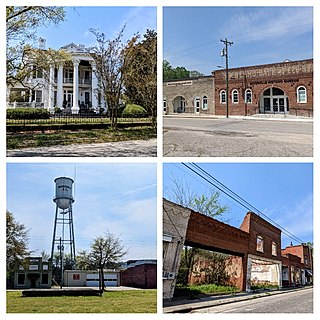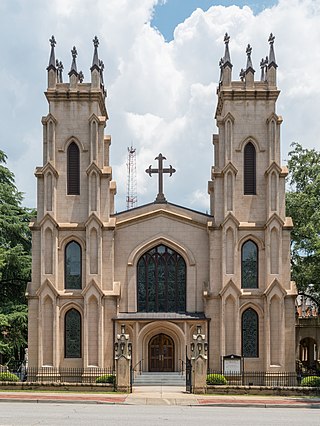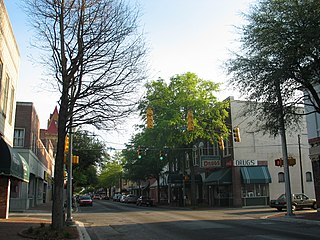
Mayesville is a town in Sumter County, South Carolina, United States. The population was 731 at the 2010 census, this was a decline from 1,001 in 2000. It is included in the Sumter, South Carolina Metropolitan Statistical Area.

Sumter is a city in and the county seat of Sumter County, South Carolina, United States. The city makes up the Sumter, SC Metropolitan Statistical Area. Sumter County, along with Clarendon and Lee counties, form the core of Sumter–Lee–Clarendon tri-county area of South Carolina that includes three counties straddling the border of the Sandhills, Pee Dee, and Lowcountry regions. The population was 43,463 at the 2020 census, making it the 9th-most populous city in the state.

Kingstree is a city in and the county seat of Williamsburg County, South Carolina, United States. The population was 3,328 at the 2010 census.

Johns Island is an island in Charleston County, South Carolina, United States, and is the largest island in the state of South Carolina. Johns Island is bordered by the Wadmalaw, Seabrook, Kiawah, Edisto, Folly, and James islands; the Stono and Kiawah rivers separate Johns Island from its border islands. It is the fourth-largest island on the US east coast, surpassed only by Long Island, Mount Desert Island and Martha's Vineyard. Johns Island is 84 square miles (220 km2) in area, with a population of 21,500.

The James Petigru Boyce Chapel is a historic church building at 1306 Hampton Street in Columbia, South Carolina. It is a Greek Revival building built in 1859. A convention met here on December 17, 1860, whose delegates voted unanimously for South Carolina to secede from the United States, leading to the American Civil War. It was designated a National Historic Landmark as First Baptist Church, the role it played at the time. The building is part of the facilities complex of the First Baptist Church, Columbia- a Southern Baptist megachurch.

Temple Sinai, also known as Congregation Sinai, whose official name is the Sumter Society of Israelites, is an historic Reform Jewish congregation and synagogue, located at 11-13 Church Street, on the corner of West Hampton Avenue, in Sumter, South Carolina, in the United States.
Singleton's Graveyard is an historic plantation cemetery located off SC 261 in the High Hills of Santee, 6 miles south of Wedgefield, South Carolina. On May 13, 1976, it was added to the National Register of Historic Places.
William Augustus Edwards, also known as William A. Edwards was an Atlanta-based American architect renowned for the educational buildings, courthouses and other public and private buildings that he designed in Florida, Georgia and his native South Carolina. More than 25 of his works have been listed on the National Register of Historic Places.

Trinity Episcopal Church, now known as Trinity Episcopal Cathedral, is the first Episcopal and the oldest surviving sanctuary in Columbia, South Carolina. It is a Gothic Revival church that is modeled after York Minster in York, England. It was named to the National Register of Historic Places on February 24, 1971.

Long Cane Associate Reformed Presbyterian Church is a historic Associate Reformed Presbyterian church in McCormick County, South Carolina four miles west of Troy, South Carolina on SC 33–36. Adjacent to the church building is a cemetery dating to circa 1790.

Ladson Presbyterian Church is a historic African American Presbyterian church located at 1720 Sumter Street in Columbia, South Carolina. The religious building was initially a chapel founded in 1838 and, rebuilt in 1896, and is a one-story-over-raised-basement, rectangular red brick building in the Renaissance Revival style. It has a front gable roof and features two brick entrance towers. The congregation was founded in 1838, as an offshoot congregation of the First Presbyterian Church.

Salem Black River Presbyterian Church is a historic church in Sumter, South Carolina.

Mary Allen Seminary was the first black women's college in the state of Texas. Initially a parochial school founded and run by white Presbyterians, it was restructured in 1924 and became an accredited junior college with an all-black faculty and black administrator in 1933. The school was closed in 1943, reopened the following year, and operated until 1972.
Maysville Historic District may refer to:
Mayesville Historic District is a national historic district located at Mayesville, Sumter County, South Carolina. It encompasses 62 contributing buildings in the western half of the town of Mayesville. It includes a broad range of late-19th and early-20th century vernacular architectural design, including commercial, residential (majority), and religious buildings. The district includes representative examples of the Neo-Classical, Victorian, Queen Anne, Colonial Revival, Greek Revival, and Bungalow. Notable buildings include the Town Hall, Kineen Hotel, Bland Stables, Granit Building, Davis Store, J. W. Rhodes House, and R. J. Mayes House.

Sumter Historic District is a national historic district located at Sumter, Sumter County, South Carolina. It encompasses 62 contributing buildings in the central business district of Sumter. It includes buildings that primarily date from 1880 to 1912. They are typical of turn-of-the-20th century commercial buildings, using materials such as pressed tin, limestone, and brick. Notable buildings include the Sumter County Courthouse, Sumter Town Hall-Opera House, Lee and Moise Building, Bultman Brothers' Boots and Shoes, Bank of Sumter, and Burns Hardware.

Rip Raps Plantation, also known as the James McBride Dabbs House, is a historic plantation house and national historic district located near Sumter, Sumter County, South Carolina. It was the home of James McBride Dabbs, author and leading advocate for social justice and civil rights (1896-1970).
Granby was the first European settlement in the area of present-day Columbia in the U.S. state of South Carolina. Settlement began around 1718 with the establishment of a trading post by the British on the Congaree River. Many small farms were settled by German, Swiss, and Scots-Irish immigrants. Granby was the largest town and county seat of Lexington County until the early 19th century, when the town began to gradually decline as Columbia, the state capital, grew. The once thriving colonial town was mostly unoccupied after the first quarter of the 19th century. Today, the area is part of present-day Cayce.
Mayesville Industrial and Educational Institute was a school for African-American children in Mayesville, South Carolina. It was established and run by Emma Jane Wilson, an African American.

















